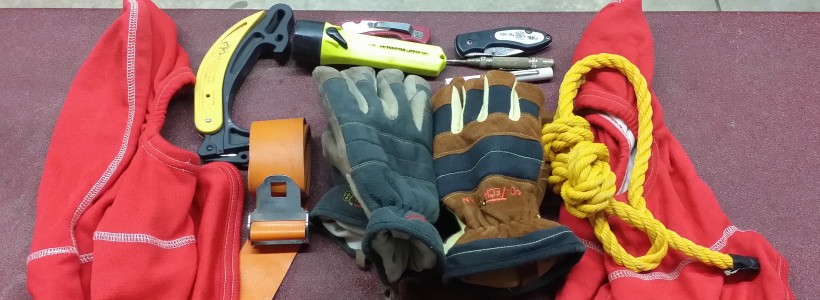9 Items Every Volunteer Firefighter Must Carry & Why – Part 1
As volunteer firefighters, we often do not have the luxury of having a specific seat to ride on the apparatus with a specific assignment. (We may also be responding directly to the scene of the call.) On one call we could be doing truck company work, on the next engine company work, and on the next rescue work. This makes having a tool kit for each type of call or assignment impractical.
Here are 9 items volunteers should carry so we can be ready for just about anything and why we should carry each. Because we need to maximize the limited space in our gear, not become too bulky, and keep each item easily accessible, I’ll also offer some tips on where and how to stow each item.
#1 – An Extra Pair Of Gloves
Have 2 pairs of gloves. How many of us have dropped a glove somewhere between the rig and the house? This way I don’t have to go hunting; I have a spare pair on me. One pair goes in the glove keeper on the outside of the bunker coat. The other pair is split: put the right glove in the right bunker pant pocket, and the left in the left bunker pant pocket. Putting them in your bunker pockets means they are easy to grab. Because they are flexible, this allows us to keep our range of motion and flexibility.
#2 – An Extra Hood
Have 2 hoods. A good way to maximize space is to keep your primary hood out and tuck it inside your helmet. A good place to keep the spare is in the inside pocket of your bunker coat. It’s out of the way, doesn’t take up space in pockets and still allows free range of motion. This also ensures if you lose your primary hood, it gets damaged or it becomes too wet, you have another at the ready.
#3 – Webbing
Webbing is great for use in vehicle extrication, removing victims from working fires, and provides us with some extra leverage. And we can use it to rescue one of our own if need be. It’s small and easy to stow.
I keep webbing in the bunker pants pocket of my dominant hand, so it is easy to grab if I need it. (Most of us grab what we need initially with our dominant hand.) Because I know where it is, I can grab it without looking.
 #4 – Window Punch
#4 – Window Punch
You never know when you might need to break out a car window in a hurry. Having it on your person at all times ensures you are ready when the need arises. Depending on the type, a window punch can also be used to help pop pins out of a residential door or to keep a door open if you don’t have webbing or wedges.
I have also used a window punch to free a hand stuck in a pickle jar.
#5 – Door/Sprinkler Wedges (Chocks)
Wedges are small things to carry but very useful during extrication, accidental sprinkler activation, searches and firefighting operations. Door wedges are also great for propping open doors when using PPV after the fire has been extinguished (a/k/a smoke removal).
The best place to carry the window punch and the wedges is on your helmet: they are easy to get to, always with you, and out of the way.
Photos courtesy of Erik Wood.
Check out the complete series here!






Do you have “always carry” suggestions for volunteers who do mostly wildland fires. We get less than 10 structures a year and about the same for vehicles. We do 200+ wildland fires though. I was in a city for the first several years and now I’m new to this. I would love tips since it’s so different. (I do carry all those items mentioned already)
no puedo ver la segunda parte me sale que no funciona la parte 2 que hago ahora
Good stuff for those that need the reminder. I especially like the wedges for AFTER the fire us out for PPV.
Any suggestions on the length of webbing to carry? Ends tied off in a water knot or kept free?
Thanks for the replies and questions. We will look to share more for wild land firefighters.
Jeff- Check out this article – https://firefightertoolbox.com/7-ways-to-use-webbing/
I am learning the wild land fire stuff after doing all structural up to this point: Things to keep in your web gear- snacks, 2 full canteens, fire shelter, pencil line and an adapter and nozzle for it, spare gloves, spare socks, chapstick, a multitool, eye and ear pro, theres other stuff that I can’t think of without looking but this is a start.
Disagree with the “extra gloves and extra hood being carried in your pockets, gear is bulky enough without caring ‘WHAT IF” things. chock, webbing with beiner , short length of rope and a knife, gloves should be on your hands, hood on your head, no chance of misplacing either. spares can be carried in your personal bag on the truck. Just MHO, stay safe